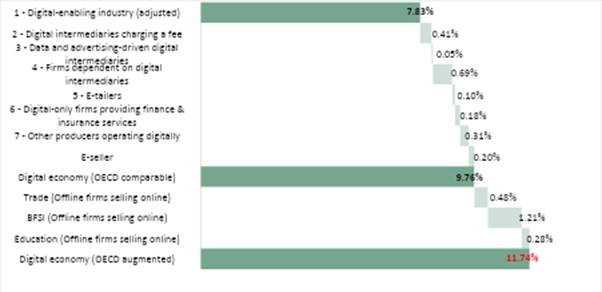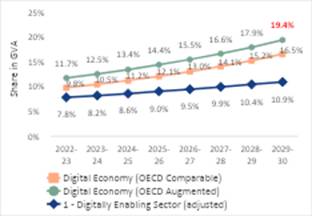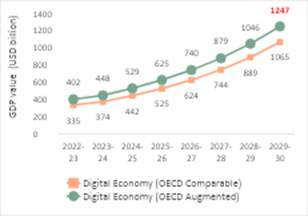Ministry of Electronics & IT
Release of Report ‘Estimation and Measurement of India’s Digital Economy’ by Ministry of Electronics & Information Technology
India’s Digital Economy estimated to reach 11.74% of National Income in 2022-23, Sets Sights on Rapid Growth
Future Ready: India’s Digital Economy to Contribute One-Fifth of GDP by 2030
प्रविष्टि तिथि:
22 JAN 2025 8:35PM by PIB Delhi
The Indian economy has been digitalising at a remarkable pace over the last decade. Yet, there are no credible and up-to-date estimates on the contribution of the digital economy to national income and employment. Quantifying and understanding the role of the digital economy in driving economic growth, employment, and sustainable development are essential for both policymakers and the private sector.
Recognizing the need for this, the Ministry of Electronics and Information Technology (MeitY) has released a comprehensive report titled ‘Estimation and Measurement of India’s Digital Economy.’ This can help align resources and adopt appropriate growth strategies.
The cross-cutting and integrated nature of digital technologies makes the concept of a distinct digital economy difficult to define and measure. Moreover, the conventional system of national accounts does not lend itself directly to the measurement of the new economy. The problem is not unique to India. Few countries have attempted to size up their digital economy and even these efforts are works in progress.
With the estimates produced in this report, India will be among a handful of countries, and the first among developing countries, to have used the Organisation for Economic Cooperation and Development (OECD) framework to produce the most up-to-date estimate for the size of its digital economy. The report also provides alternate estimates using the input-output approach advocated by the Asian Development Bank (ADB). The report goes beyond the OECD approach to also include the digital share of traditional industries like trade, banking, financial services, and insurance (BFSI) and education.
India’s digital economy is estimated at 11.74% of the national income in 2022-23. In absolute numbers, the digital economy in 2022-23 was equivalent to INR 31.64 lakh crore (~USD 402 billion) in GDP.
The digital-enabling industry, which includes sectors such as information and communication related services, telecommunication (traditionally referred to as the ICT sector), and manufacturing of electronic components, computers, and communication equipment, is the highest contributor, accounting for 7.83% of GVA. The new digital industries, which include Big Tech players, other digital platforms and intermediaries, and firms dependent on digital intermediaries, account for nearly 2% of GVA. The digital contribution of three traditional industries (BFSI, trade, and education), which are not part of the OECD framework but are included in our estimates, amounts to 2% of national GVA, rivalling in importance to the new digital industries. This is a clear indication that India’s digital economy is steadily moving beyond the realm of the ICT industries, diffusing across all parts of the economy through digital platforms and the digitalisation of brick-and-mortar sectors.
|
Figure 1: Share of India’s Digital Economy
|
|

|
Based on the projections in the report, India’s digital economy is expected to grow almost twice as fast as the overall economy, contributing to nearly one-fifth of national income by 2030 (see Figure 2). In the short run, the highest growth is likely to come from the growth of digital intermediaries and platforms, followed by higher digital diffusion and digitalisation of the rest of the economy. In 2022-23, the digital economy accounted for 14.67 million workers, or 2.55% of India’s estimated work force.
|
Figure 2: Projected growth of India’s Digital Economy
|
|

|

|
The estimates, in the report, are conservative due to unavailability of data on (i) smaller digital platforms, (ii) digitalization of the informal sector and (iii) digitalization of other traditional sectors such as health and logistics which are not included under new digital businesses.
This report is an attempt to compile the first set of credible, comprehensible, and current estimates of India’s digital economy based on an internationally accepted framework. The insights from this report are invaluable for policymakers, businesses, and other stakeholders. Accurate data on the digital economy will allow for more effective policy decisions, enabling targeted interventions and investments to support digital growth. For businesses, understanding the contribution of digital technologies to their sectors can help inform strategic decisions, drive innovation, and increase competitiveness in a globalized market.
The complete report is available at https://www.meity.gov.in/content/report-estimation-and-measurement-indias-digital-economy
****
Dharmendra Tewari/Kshitij Singha
(रिलीज़ आईडी: 2095260)
आगंतुक पटल : 5506